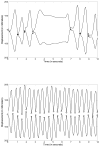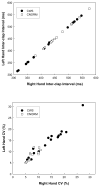Evidence that a motor timing deficit is a factor in the development of stuttering
- PMID: 20220024
- PMCID: PMC3918902
- DOI: 10.1044/1092-4388(2009/09-0007)
Evidence that a motor timing deficit is a factor in the development of stuttering
Abstract
Purpose: To determine whether young children who stutter have a basic motor timing and/or a coordination deficit.
Method: Between-hands coordination and variability of rhythmic motor timing were assessed in 17 children who stutter (4-6 years of age) and 13 age-matched controls. Children clapped in rhythm with a metronome with a 600-ms interbeat interval and then attempted to continue to match this target rate for 32 unpaced claps.
Results: Children who stutter did not significantly differ from children who were typically developing on mean clapping rate or number of usable trials produced; however, they produced remarkably higher variability levels of interclap interval. Of particular interest was the bimodal distribution of the stuttering children on clapping variability. One subgroup of children who stutter clustered within the normal range, but 60% of the children who stutter exhibited timing variability that was greater than the poorest performing nonstuttering child. Children who stutter were not more variable in measures of coordination between the 2 hands (mean and median phase difference between hands).
Conclusion: We infer that there is a subgroup of young stuttering children who exhibit a nonspeech motor timing deficit, and we discuss this result as it pertains to recovery or persistence of stuttering.
Figures


Similar articles
-
Evidence That Bimanual Motor Timing Performance Is Not a Significant Factor in Developmental Stuttering.J Speech Lang Hear Res. 2016 Aug 1;59(4):674-85. doi: 10.1044/2016_JSLHR-S-15-0172. J Speech Lang Hear Res. 2016. PMID: 27391252 Free PMC article.
-
Adults who stutter and metronome synchronization: evidence for a nonspeech timing deficit.Ann N Y Acad Sci. 2019 Aug;1449(1):56-69. doi: 10.1111/nyas.14117. Epub 2019 May 29. Ann N Y Acad Sci. 2019. PMID: 31144336 Free PMC article.
-
Evidence for a rhythm perception deficit in children who stutter.Brain Lang. 2015 May;144:26-34. doi: 10.1016/j.bandl.2015.03.008. Epub 2015 Apr 13. Brain Lang. 2015. PMID: 25880903 Free PMC article.
-
Stuttering in relation to anxiety, temperament, and personality: review and analysis with focus on causality.J Fluency Disord. 2014 Jun;40:5-21. doi: 10.1016/j.jfludis.2014.01.004. Epub 2014 Feb 8. J Fluency Disord. 2014. PMID: 24929463 Review.
-
Anxiety of children and adolescents who stutter: a review.J Fluency Disord. 2014 Jun;40:22-34. doi: 10.1016/j.jfludis.2014.01.003. Epub 2014 Feb 9. J Fluency Disord. 2014. PMID: 24929464 Review.
Cited by
-
Processing rhythm in speech and music: Shared mechanisms and implications for developmental speech and language disorders.Neuropsychology. 2021 Nov;35(8):771-791. doi: 10.1037/neu0000766. Epub 2021 Aug 26. Neuropsychology. 2021. PMID: 34435803 Free PMC article. Review.
-
Executive Functions Impact the Relation Between Respiratory Sinus Arrhythmia and Frequency of Stuttering in Young Children Who Do and Do Not Stutter.J Speech Lang Hear Res. 2017 Aug 16;60(8):2133-2150. doi: 10.1044/2017_JSLHR-S-16-0113. J Speech Lang Hear Res. 2017. PMID: 28763803 Free PMC article.
-
A preliminary investigation of segmentation and rhyme abilities of children who stutter.J Fluency Disord. 2013 Jun;38(2):222-34. doi: 10.1016/j.jfludis.2012.12.004. Epub 2013 Jan 10. J Fluency Disord. 2013. PMID: 23773673 Free PMC article.
-
Evidence for a Resting State Network Abnormality in Adults Who Stutter.Front Integr Neurosci. 2018 Apr 27;12:16. doi: 10.3389/fnint.2018.00016. eCollection 2018. Front Integr Neurosci. 2018. PMID: 29755328 Free PMC article.
-
Control and prediction components of movement planning in stuttering versus nonstuttering adults.J Speech Lang Hear Res. 2014 Dec;57(6):2131-41. doi: 10.1044/2014_JSLHR-S-13-0333. J Speech Lang Hear Res. 2014. PMID: 25203459 Free PMC article.
References
-
- Ambrose N, Yairi E. Normative data for early childhood stuttering. Journal of Speech, Language, & Hearing Research. 1999;42:895–909. - PubMed
-
- Arndt J, Healey CE. Concomitant disorders in school-age children who stutter. Language, Speech, and Hearing Services in Schools. 2001;32:68–78. - PubMed
-
- Bengtsson SL, Ehrsson HH, Forssberg H, Ullen F. Effector-independent voluntary timing: Behavioral and neuroimaging evidence. European Journal of Neuroscience. 2005;22:3255–3265. - PubMed
-
- Binkofski F, Buccino G. Motor functions of the Broca’s region. Brain and Language. 2004;89:362–369. - PubMed
-
- Boutsen FR, Brutten GJ, Watts CR. Timing and intensity variability in the metronomic speech of stuttering and nonstuttering speakers. Journal of Speech, Language, and Hearing Disorders. 2000;43:513–520. - PubMed
Publication types
MeSH terms
Grants and funding
LinkOut - more resources
Full Text Sources
Medical

